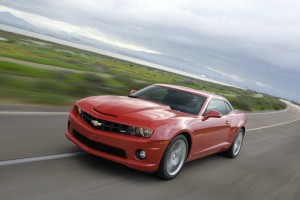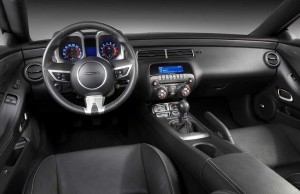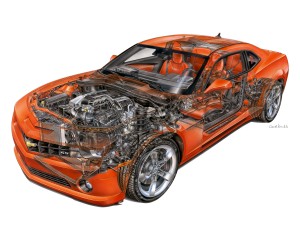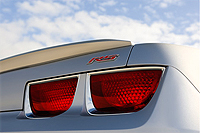
The new Chevrolet Camaro is finally on the road.
“Timing,” goes the old adage, “is everything.” But at this particular moment, it’s not easy to say whether the return of the Chevrolet Camaro is timed perfectly or primed for failure.
You might decide yourself, after checking out these pics of the production Camaro. But there’s no question, Chevy’s parent, General Motors, certainly could use a hit, and it’s going to put some heavy promotional dollars behind the arrival of the new pony car at U.S. dealer showrooms. But marketing dollars are scarce, and so are U.S. car buyers, the current market operating at less than a 10 million annual rate, compared with more than 17 million earlier in the decade.
Meanwhile, it’s unclear how American motorists will view a high-performance muscle car, even with the current slump in fuel prices. But Chevy plans to expand its Camaro line-up, both up and down market. It hopes to give chase to the current leader in the muscle car segment, Ford’s Mustang, while also offering more fuel-stingy V-6 engines for those who might like the look of the new Camaro, but without the tire-squealing torque.
TheDetroitBureau.com will get its first chance to get behind the wheel of the new Camaro, later this week, and we’ll have plenty to tell you when we’re done.
In the meantime, turn the page for the complete press release on the new Camaro.

Interior of the high-performance Camaro SS.
DETROIT– The wait is over. After a seven-year hiatus, the new Chevrolet Camaro is now back in dealer showrooms.
Combining great looks, performance and advanced technology, the 2010 Camaro honors its heritage while delivering on customer expectations of a sports coupe for the 21st century.
“The new Camaro delivers a modern, advanced package of performance, comfort and technology,” said Ed Peper, Chevrolet general manager and General Motors vice president. “It’s a personal car for a generation of enthusiasts, both young and old, that honors the Camaro’s heritage with a thoroughly contemporary design.
Built on the new global rear-wheel-drive passenger car platform, Camaro embodies GM’s global vehicle development and design process. The original design concept was conceived in the United States, with engineering shared by both Australia and U.S. teams. Validation was conducted on roads throughout the world and assembly is handled by GM’s award-winning plant in Oshawa, Ontario, Canada.
Design features
With a design that is very close to the original concept, the 2010 Camaro acknowledges its heritage from the first-generation Camaro, produced from 1967 through 1969. The two-door sports coupe features classic proportions over a 112.3-inch (2,852 mm) wheelbase. The overall length of the Camaro is 190.4 inches (4,836 mm); width and height are 75.5 inches (1,918 mm) and 54.2 inches (1,376 mm), respectively.
The long hood and short deck are pushed to the far corners of the muscular fender forms and a fast, 67-degree rake windshield contributes to aerodynamic performance that includes a 0.37 coefficient of drag (Cd) on V-6 models and a slightly sleeker 0.35 Cd on the V-8-powered SS model.
 Wheel arch openings received special attention through the design process. Whether the Camaro is equipped with the standard 18-inch, or optional 19-inch or 20-inch wheels, the relationship of the top of the tire and bottom of the fender is consistent on all models. All models also feature the classic “V” design motif in the nose, along with a 2.5-inch (63.5 mm) power dome in the aluminum hood, reminiscent of high-performance Camaro models. On SS models, a simulated air intake is located in the upper front fascia and the lower air intake is larger.
Wheel arch openings received special attention through the design process. Whether the Camaro is equipped with the standard 18-inch, or optional 19-inch or 20-inch wheels, the relationship of the top of the tire and bottom of the fender is consistent on all models. All models also feature the classic “V” design motif in the nose, along with a 2.5-inch (63.5 mm) power dome in the aluminum hood, reminiscent of high-performance Camaro models. On SS models, a simulated air intake is located in the upper front fascia and the lower air intake is larger.
On the top, designers took a cue from Corvette and sculpted twin cockpits across the roof, giving the vehicle a distinctive Chevrolet presence. From the outside, the B-pillar is invisible to the eye, lending the true appearance of a hardtop coupe. The B-pillar is designed to provide increased structural rigidity to the car. And to ensure quality in the manufacturing process, a one-piece body stamping provides a cleaner overall side appearance that is free of seams, gaps or plastic appliqués. “Gills” located in the front of the rear quarter panel also are familiar Camaro styling cues.
Ten exterior colors are available and include Black, Victory Red, Rally Yellow and Silver Ice Metallic. Red Jewel Tintcoat is also available as an option. The color palette also includes Cyber Gray Metallic, Aqua Blue Metallic, Inferno Orange Metallic, White and Imperial Blue Metallic.
An RS appearance package is available on LT and SS. It includes HID headlamps with integrated halo rings, a rear spoiler on LT, specific taillamps and 20-inch wheels with a Midnight Silver finish.
Interior details
Inside the four-passenger cabin, a well-executed balance of heritage, modern design and attention to detail conveys simplicity and refinement with contemporary details in the cluster, switches, dials and lighting. An available ambient light package, for example, offers advanced LED light pipe technology, giving the cabin a distinctive glow.
Deep, recessed gauges, located in square housings outlined in chrome, give a nod to the classic Camaro interior. The instrument panel gauges include both speedometer and engine rpm, with a driver information center located between the large gauges – its readouts and features controlled via a stalk on the steering column. An optional, console-mounted gauge package includes oil pressure, oil temperature, volts and transmission fluid temperature. The gauge package is included on 2LT and 2SS models.
Cloth upholstery is standard and leather-appointed seats are included on 2LT and 2SS models. Four-way manual adjustment including fore/aft and up/down on the driver seat and two-way adjustment on the passenger seat is standard. Heated, leather-trimmed seats with driver six-way power adjustment are optional.
Both LT and SS standard cloth and available leather interior colors are black, gray and beige. The front seat travel is a generous 8.5 inches (216 mm) from front to back. On SS models, the seats feature a distinctive SS logo on the headrest with contrasting stitching. An Inferno Orange interior trim package also will be available with leather interiors.
All models include a three-spoke steering wheel with manual tilt/telescope adjustment. Cruise control and rear defog also are standard, while a leather-wrapped steering wheel and shift knob; redundant steering wheel controls; Bluetooth and USB port are part of the available Driver Convenience and Connectivity package. Also included in the package is remote start on automatic transmission-equipped vehicles, as well as a personal device interface module for iPods.
Soon after production begins, customers will be able to order a short-throw Hurst shifter that provides quick, concise shifting.
Camaro’s entertainment systems include a single-CD radio with six speakers that is standard on LS, LT and SS models. A premium, 245-watt Boston Acoustics nine-speaker audio system can be ordered on 1LT and SS models. XM Satellite Radio is standard on all models.
All models also include power door locks and express up and down driver and passenger window. Cargo capacity can be increased with the standard fold-down rear seat. The capacity of the trunk is 11.3 cubic feet (320 liters).
Safety
The Camaro offers a comprehensive system of safety features – starting with a robust body structure and integral safety cage around the passenger compartment. High-strength steel and ultra high-strength steels are used in key areas throughout the structure. Safety technologies also include:
- Driver and front passenger dual-stage air bags
- Driver and front passenger seat-mounted thorax side-impact air bags
- Head curtain side-impact air bags for front- and rear-seat occupants
- Front-seat safety belt load limiters and pretensioners
- A front passenger detection system that senses children and small-stature adults, and suppresses air bag deployment when appropriate.
 In both doors, an interlock pin is utilized to prevent intrusion into the passenger compartment and adds stiffness to the door structure by engaging with a clevis bracket set into the rocker panel.
In both doors, an interlock pin is utilized to prevent intrusion into the passenger compartment and adds stiffness to the door structure by engaging with a clevis bracket set into the rocker panel.
